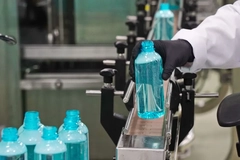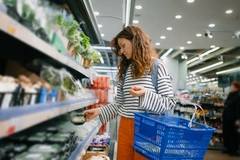Sealpac’s new FlatSkin “hanging” pack achieves 75 percent plastic reduction

13 Aug 2018 --- Sealpac’s FlatSkin pack combines extended shelf-life and enhanced design appeal with a plastic reduction of up to 75 percent. Danish seafood processor Vega Salmon A/S is one of the early adopters of the FlatSkin packaging system for its hot-smoked salmon products. The products are manufactured on a Sealpac A10 traysealer with 8-impression tooling for cardboard carriers measuring 260 x 130 mm. Each carrier has a double-sided print and hanger hole, which, combined with Sealpac’s unique OnTrayCut system, allow for an attractive vertical presentation at retail.
Skin packs are an increasingly popular form of packaging for fresh food. The advantages of the skin packaging system are obvious: securely sealed under deep vacuum, food products have a significantly longer shelf-life and can be presented in a much more attractive way. Sealpac’s FlatSkin also achieves a 75 percent plastic reduction.

“FlatSkin was developed in light of the growing demand for sustainability, strongly driven by retailers,” Marcel Veenstra, Marketing & Communications Manager at SEALPAC, tells PackagingInsights. “Sealpac’s recently developed FlatSkin system provides the answer: it combines an attractive product presentation and extended shelf-life with a highly sustainable use of packaging materials.”
“Instead of common plastic skin trays, the FlatSkin system uses cardboard carriers. Each carrier is coated with a polymeric protective layer that provides stability to the cardboard and forms a barrier against grease, moisture and oxygen. A highly transparent barrier skin film fixates the product directly onto its flat support, which allows for excellent vertical presentation. After taking out the product, the thin polymeric layer is easily removed from the cardboard to allow for separate disposal. Compared to traditional vacuum skin packaging, the FlatSkin system is able to achieve a plastic reduction of up to 75 percent,” he says.
Technical challenges
The FlatSkin pack differs from traditional vacuum skin packaging with plastic trays in two main ways, according to Veenstra: “Firstly, we are working with cardboard material: as cardboard is sensitive to humidity, it will bend relatively quickly. That would naturally have a negative impact on the pack presentation. Together with our partner VG Nicolaus, we have been able to develop a cardboard carrier that does not bend easily throughout the entire chain.”
“Secondly, the cardboard carrier is completely flat: this provided a challenge with regard to the transport of the cardboard carriers on our in-feed conveyor. Here, we now use our special SmartCord in-feed system.”
Hanging presentation
Veenstra explains the advantages of the hanging presentation – a shelf-appeal technique widely used in Switzerland: “The main advantage of a hanging presentation is that it gives the consumer a full view of the product.” Alternatively, the FlatSkin packs can also be presented standing in a cardboard box, nicely positioned behind each other. The 3D effect of vacuum skin packaging additionally allows the consumer to ‘feel’ the product. It doesn’t come more honest than that,” he says.

“We currently have applications for fresh meat, seafood, cheese and processed meat (e.g. BBQ items), but the system is suitable for any food product that is currently already packaged under vacuum. Poultry, sausages and vegetarian foods would also be appropriate for a sustainable and striking FlatSkin presentation,” he adds.
Danish seafood processor Vega Salmon A/S, with its head office in Kolding, is one of the first users of the FlatSkin packaging system for its hot-smoked salmon products, which it supplies under different brand names to various retailers.
By Joshua Poole











